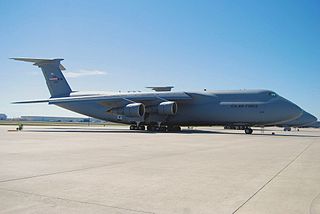
The 16th Airlift Squadron is an active unit of the United States Air Force, assigned to the 437th Airlift Wing, Air Mobility Command. It is based at Joint Base Charleston, South Carolina. The squadron operates Boeing C-17 Globemaster III aircraft supporting the United States Air Force global reach mission worldwide.

The 374th Airlift Wing is a unit of the United States Air Force assigned to Fifth Air Force. It is stationed at Yokota Air Base, Japan. It is part of Pacific Air Forces. The 374th Airlift Wing is the only airlift wing in PACAF and provides airlift support to all Department of Defense agencies in the Pacific theater of operation. It also provides transport for people and equipment throughout the Kantō Plain and the Tokyo metropolitan area.

The 50th Air Refueling Squadron is a unit of the US Air Force, assigned to the 6th Operations Group, 6th Air Refueling Wing at MacDill Air Force Base, Florida. It operates the Boeing KC-135R Stratotanker aircraft conducting air refueling missions.

The 7th Airlift Squadron is part of the 62d Airlift Wing at McChord Air Force Base, Washington. It operates Boeing C-17 Globemaster III aircraft supporting the United States Air Force global reach mission worldwide.

The 61st Airlift Squadron is a United States Air Force unit assigned to the Air Mobility Command's 19th Airlift Wing at Little Rock Air Force Base, Arkansas. It operates Lockheed C-130J Hercules aircraft for airlift and airdrop operations.

The 8th Airlift Squadron is part of the 62d Airlift Wing at Joint Base Lewis-McChord,, Washington. It operates Boeing C-17 Globemaster III aircraft supporting the United States Air Force global reach mission worldwide.

The 4th Airlift Squadron is part of the 62d Airlift Wing at Joint Base Lewis-McChord,, Washington. It operates Boeing C-17 Globemaster III aircraft supporting the United States Air Force global reach mission worldwide.

The 22nd Airlift Squadron, sometimes written as 22d Airlift Squadron, is part of the 60th Air Mobility Wing at Travis Air Force Base, California. It operates C-5M Galaxy aircraft supporting the United States Air Force global reach mission worldwide. The mission is to provide services and support which promote quality of life and project global power through combat-proven airlift and airdrop.

The 36th Airlift Squadron is an airlift squadron of the United States Air Force. It is part of the 374th Operations Group at Yokota Air Base, Japan.

The 48th Airlift Squadron was part of the 314th Airlift Wing at Little Rock Air Force Base, Arkansas. It operates Lockheed Martin C-130J Super Hercules aircraft, conducting pilot and loadmaster training for airlift and airdrop operations.

The 62nd Airlift Squadron is part of the 314th Airlift Wing at Little Rock Air Force Base, Arkansas. Originally constituted in 1942 as the 62nd Troop Carrier Squadron, it first deployed to Morocco in 1943, remaining in Europe until its inactivation in 1946. It reactivated three years later and deployed to Japan during the Korean War. In 1967, the unit was redesignated the 62nd Tactical Airlift Squadron, and in 1991 the 62nd Airlift Squadron. It operates Lockheed C-130J Super Hercules aircraft and provides advanced training to pilots, copilots, and loadmasters for combat airlift and airdrop operations.

The 517th Airlift Squadron is an active unit of the United States Air Force, Pacific Air Forces 3d Wing at Joint Base Elmendorf–Richardson, Alaska. It operates Beechcraft C-12 Huron and Boeing C-17 Globemaster III aircraft providing airlift in the Pacific theater.

The 313th Expeditionary Operations Group is a Provisional United States Air Force unit, assigned to United States Air Forces in Europe to activate or inactivate as needed. It was last active at Moron Air Base, Spain, supporting Operations Odyssey Dawn and Unified Protector to enforce a no-fly zone over Libya. It was inactivated on 31 October 2011.

The 47th Airlift Flight is an inactive United States Air Force unit. Its last assignment was with the 375th Airlift Wing at Wright-Patterson Air Force Base, Ohio, where it served as an operational support airlift flight, operating Learjet C-21s from 1997 until 2004.

The 314th Operations Group is the flying component of the Air Education and Training Command 314th Airlift Wing, stationed at Little Rock Air Force Base, Arkansas.

The 433rd Operations Group is the operational flying component of the United States Air Force Reserve 433rd Airlift Wing. It is stationed at Lackland Air Force Base, Texas.

The 374th Operations Group is the operational flying component of the United States Air Force 374th Airlift Wing. It is stationed at Yokota Air Base, Japan.

The 29th Weapons Squadron is a United States Air Force unit, stationed at Little Rock Air Force Base, Arkansas. It is assigned to the USAF Weapons School at Nellis Air Force Base. The mission of the squadron is to provide advanced Lockheed C-130J Hercules instructional flying.

The 57th Weapons Squadron is a United States Air Force unit. It is assigned to the USAF Weapons School, stationed at the McChord AFB component of Joint Base Lewis-McChord, Washington. The squadron is a geographically separated unit of the 57th Wing at Nellis Air Force Base, Nevada. The mission of the squadron is to provide Boeing C-17 Globemaster III instructional flying.

The 772nd Expeditionary Airlift Squadron is a provisional United States Air Force unit, assigned to Air Combat Command to activate or inactivate as needed. Its most recent known deployment was with the 451st Air Expeditionary Wing at Kandahar Airfield, Afghanistan prior to the United States withdrawal from Afghanistan.






























